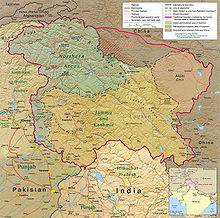Kashmir is the northernmost geographical region of the Indian subcontinent. Until the mid-19th century, the term “Kashmir” denoted only the Kashmir Valley between the Great Himalayas and the Pir Panjal Range. Today, it denotes a larger area that includes the Indian-administered territory of Jammu and Kashmir(which includes the region of Jammu, Kashmir Valley, Ladakh and Siachen), the Pakistani-administered territories of Azad Kashmir and Gilgit-Baltistan, and Chinese-administered territories of Aksai Chin and the Trans-Karakoram Tract.[1][2][3]
In the first half of the 1st millennium, the Kashmir region became an important centre of Hinduism and later of Buddhism; later still, in the ninth century, Kashmir Shaivismarose.[4] In 1339, Shah Mir became the first Muslim ruler of Kashmir, inaugurating the Salatin-i-Kashmir or Shah Mir dynasty.[5]Kashmir was part of the Mughal Empire from 1586 to 1751,[6] and thereafter, until 1820, of the Afghan Durrani Empire.[5] That year, the Sikhs, under Ranjit Singh, annexed Kashmir.[5]In 1846, after the Sikh defeat in the First Anglo-Sikh War, and upon the purchase of the region from the British under the Treaty of Amritsar, the Raja of Jammu, Gulab Singh, became the new ruler of Kashmir. The rule of his descendants, under the paramountcy (or tutelage) of the British Crown, lasted until the partition of India in 1947, when the former princely state of the British Raj was claimed by both Pakistan and India.
Since 1947, the greater region of Jammu and Kashmir has been embroiled in a territorial dispute between India, Pakistan and China — with India controlling approximately 43% of the region and 70% of its population. Pakistan controls roughly 37% of the region while China controls the remaining 20%.[7][1][2] Kashmir is widely regarded as the world’s most militarized zone — the region has witnessed three major wars between India and Pakistan, another limited war between India and China, numerous border skirmishes, high mountainous warfare, an ongoing insurgency, a mass Hindu exodus and internal civilian unrest.[8]



